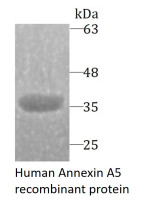ARG70472
Human Annexin A5 recombinant protein (His-tagged, C-ter)
Human Annexin A5 recombinant protein (His-tagged, C-ter) for SDS-PAGE
Overview
| Product Description | E. coli expressed, His-tagged (C-ter) Human Annexin A5 recombinant protein |
|---|---|
| Tested Application | SDS-PAGE |
| Target Name | Annexin A5 |
| Species | Human |
| A.A. Sequence | Met1 - Asp320 |
| Expression System | E. coli |
| Protein Full Name | Annexin A5 |
| Alternate Names | ANXA5; Annexin A5; CPB-I; PAP-I; Placental Anticoagulant Protein I; Vascular Anticoagulant-Alpha; Calphobindin I; Endonexin II; Annexin V; VAC-Alph; RPRGL3; ANX5 |
Properties
| Form | Powder |
|---|---|
| Purification Note | Endotoxin level is less than 0.1 EU/µg of the protein, as determined by the LAL test. |
| Purity | > 98% (by SDS-PAGE) |
| Buffer | PBS (pH 7.4) |
| Reconstitution | It is recommended to reconstitute the lyophilized protein in sterile water to a concentration not less than 200 μg/mL and incubate the stock solution for at least 20 min at room temperature to make sure the protein is dissolved completely. |
| Storage Instruction | For long term, lyophilized protein should be stored at -20°C or -80°C. After reconstitution, aliquot and store at -20°C or -80°C for up to one month. Storage in frost free freezers is not recommended. Avoid repeated freeze/thaw cycles. Suggest spin the vial prior to opening. |
| Note | For laboratory research only, not for drug, diagnostic or other use. |
Bioinformation
| Gene Symbol | ANXA5 |
|---|---|
| Gene Full Name | ANXA5 |
| Background | The Annexin 5 gene spans 29 kb containing 13 exons, and encodes a single transcript of approximately 1.6 kb and a protein product with a molecular weight of about 35 kDa.The protein encoded by this gene belongs to the annexin family of calcium-dependent phospholipid binding proteins some of which have been implicated in membrane-related events along exocytotic and endocytotic pathways. Annexin 5 is a phospholipase A2 and protein kinase C inhibitory protein with calcium channel activity and a potential role in cellular signal transduction, inflammation, growth and differentiation. Annexin 5 has also been described as placental anticoagulant protein I, vascular anticoagulant-alpha, endonexin II, lipocortin V, placental protein 4 and anchorin CII. Polymorphisms in this gene have been implicated in various obstetric complications. |
| Function | This protein is an anticoagulant protein that acts as an indirect inhibitor of the thromboplastin-specific complex, which is involved in the blood coagulation cascade. |
| Cellular Localization | Cytoplasm, cytosol, endothelial microparticle, external side of plasma membrane, extracellular exosome, extracellular region, focal adhesion, membrane |
| PTM | Acetylation, Isopeptide bond, Phosphoprotein, S-nitrosylation, Ubl conjugation |
Images (1) Click the Picture to Zoom In






